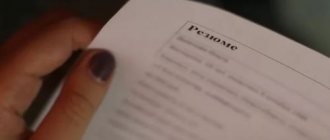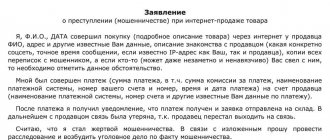What is a claim for damages?
The legislation of the Russian Federation regulates legal liability in all cases where damage is caused to citizens, regardless of whether this was done voluntarily or involuntarily. According to the Constitution of the Russian Federation, every citizen has the right to compensation for damage and payment for moral damage. When a claim is filed, this right is exercised in practice.
Citizens have the right to demand compensation for losses from individuals and legal entities, from government agencies and institutions.
Individuals and legal entities can act as plaintiffs and defendants. Drawing up a claim document is a crucial moment, since the correct execution determines whether the court will accept the claim for consideration.
Anyone who is not involved in jurisprudence should use the services of a professional lawyer to draw up this document. Experts will help you file a claim for damages in the required format and with content appropriate to the situation, and will give advice on what to do after the trial begins.
From a legal point of view, a statement of claim is a classic opportunity to protect civil rights by legal means in cases where damage has been caused to citizens or their property. Such claims are considered by courts of general jurisdiction.
Citizens may bring claims in a claim:
- Material (property) – arise if the property of a company or individual is damaged. Property damage is expressed in monetary terms.
- Moral - arise as a result of illegal actions or lack of necessary actions of the subject in his address. When filing a claim for moral damage, the applicant must prove that he suffered moral suffering.
Claim for compensation for material damage: sample
February 11, 2021 (indicate the date when the damage was caused) to the property owned by me, namely: apartment No. 72 of building No. 187 on the street. Lenin (indicate the subject, a list of property with individual characteristics). Ownership of the specified item(s) is confirmed by purchase and sale agreement No. 8 dated March 19, 2014 (purchase and sale agreement, certificate of registration of ownership, etc.).
- collect all known data on the defendant (his address, surname, first name and patronymic, contact number are required);
- collect and document all data that can serve as evidence in the case;
- conduct a preliminary conversation with witnesses, finding out whether they are ready to give confirming/refuting evidence when considering the claim;
- if witnesses do not want to spend their personal time attending court, their testimony should be recorded in writing, indicating and confirming their personal data.
We recommend reading: Registration of inheritance after death cost
About registration requirements
The sample statement of claim for recovery of damages is similar to other samples of claims in civil proceedings, so they are freely available, you can download them and familiarize yourself with the rules for drafting.
The claim is drawn up and accepted by the court, provided that its content complies with the rules and requirements for its format defined by law:
- Name of the authority to which the claim is filed, address of location.
- Applicant details: Full name, residential address. For organizations - name and location in the locality.
- Information about the defendant.
- The plaintiff's claims and demands in essence. The information must be confirmed by references to the articles of law that guide the victim.
- Description of the circumstances underlying the dispute.
- An indication of the amount of compensation for moral damage with a description of the requirements for which the applicant is seeking payment.
- A description of attempts to resolve the situation peacefully, if any.
- List of applications.
How to recover damages? Current positions of judicial practice that will help in court
Despite the fact that the reform of the Civil Code of the Russian Federation has lowered the standard of proof in disputes about the recovery of losses, in practice it is still difficult to prove them. Courts award plaintiffs on average only 39% of the amounts claimed. What positions of judicial practice on damages should participants in disputes pay attention to? Is it possible to limit the scope of liability in a contract?
They say:
Vera Richterman,
Partner in the judicial and arbitration practice of Egorov, Puginsky, Afanasyev and Partners Law Firm
Vladimir Rodionov,
lawyer in judicial and arbitration practice at Egorov, Puginsky, Afanasiev and Partners Law Firm
Recovery of damages is a universal way to protect a violated right. However, today business is experiencing difficulties in proving both the fact of causing losses and their size.
When a large-scale reform of the Civil Code of the Russian Federation was carried out 6 years ago, it seemed that the situation with the recovery of losses should improve and they would become a more effective tool for protecting the interests of business. However, today there are still many questions.
ON A NOTE
Judicial statistics show a gradual, very significant decrease in the number of disputes regarding the recovery of damages from contracts since 2021.
In 2021 there were about 9 thousand of them - this is 3 times less than in 2021. Over the past 5 years, on average, the courts have satisfied about 75% of claims for damages. It's a good news. However, there is also a bad thing: on average, courts recover only 39% of the amounts of declared claims, that is, significantly less than half.
This suggests that:
- the business has difficulty proving losses,
- business trusts this institution less and less, preferring alternatives, such as collecting penalties.
Common cases of recovery of damages
Breach of contract, including the future . The most common case of recovery of damages is a breach of contract (for example, the counterparty did not deliver the goods or delivered the goods of inadequate quality). The violation can be either past or future: if your counterparty obviously cannot fulfill the agreement, you can refuse this agreement and recover damages from it (Clause 2 of Article 328 of the Civil Code of the Russian Federation). For example, if the customer understands that the contractor will not have time to complete the building on time, he refuses the contract and recovers damages from the contractor (Clause 2 of Article 715 of the Civil Code of the Russian Federation).
Making false representations is another example of a potential damages recovery situation. Moreover, in commercial contracts, losses can be recovered even if the counterparty did not know that his assurances were unreliable (clause 4 of Article 431.2 of the Civil Code of the Russian Federation).
Breach of Fiduciary Duty . We are talking, first of all, about liability within the framework of corporate relations - recovery of losses from the company's management and controlling persons (Article 53.1 of the Civil Code of the Russian Federation).
Causing non-contractual harm . There are typical situations, for example, violations of intellectual rights, when the patent holder demands to recover damages. But there are also non-standard cases.
CASE STUDY
The court made a decision recognizing the plaintiff's ownership of the premises on the basis of forged documents.
When it became clear that evidence had been falsified, the losing party was able not only to return its property, but also to recover 10 million rubles in damages from the plaintiff. This was lost profit resulting from the losing party being deprived of the right to use their property for 4 months. Ruling of the Supreme Court of the Russian Federation dated December 20, 2018 No. 305-ES18-14652 in case No. A40-135360/2017
Compensation for losses caused by lawful actions. We are talking, among other things, about losses caused to a person in connection with the exercise by his counterparty of the right to arbitrarily refuse the contract (for example, Article 717 of the Civil Code of the Russian Federation).
The given grounds do not exhaust the possible cases of recovery of damages. This is a universal method of protection that can be used in a variety of situations.
Real damage and lost profits
Losses are divided into actual damage and lost profits.
At first glance, this division seems purely theoretical, but in fact it also has practical consequences, for example:
- claims for recovery of lost profits are not taken into account when determining the signs of bankruptcy (clause 2 of article 4 of the Federal Law of October 26, 2002 No. 127-FZ “On Insolvency (Bankruptcy)”),
- within the framework of bankruptcy, claims for recovery of lost profits are subject to subordination (clause 3 of Article 137 of the Federal Law of October 26, 2002 No. 127-FZ “On Insolvency (Bankruptcy)”),
- recovery of lost profits is often blocked by law (for example, in an energy supply agreement under clause 1 of Article 547 of the Civil Code of the Russian Federation) or by contract.
In this regard, there are often disputes in the courts in which a party tries to prove that its losses are actual damage and not lost profits.
Actual damage may include:
- costs associated with breach of contract. For example, the counterparty did not deliver the goods, and therefore the ship is idle at the port - you can recover damages for the demurrage of the vessel;
- expenses for concluding a replacement transaction: the supplier promised to sell 100 units of goods at 100 rubles each, but did not fulfill the agreement. A week later, the buyer had to purchase the same quantity of goods for 120 rubles per piece. A delta of 20 rubles per piece is the amount of damages that the buyer can recover from the first supplier;
- the value of the destroyed property;
- costs of restoring rights, in particular costs of repairing damaged property.
ON A NOTE
If, due to the fault of a counterparty, a person was unable to participate in a closed competition, will it be possible to recover losses?
The Russian court will most likely refuse to collect. There is an institute for recovering damages for lost chances abroad. If 4 companies took part in a closed competition, then the fifth participant, who was unable to participate due to his counterparty, would have a 20% chance of winning. He lost the chance to participate in the competition due to the fault of the counterparty, so he could have collected 20% of the contract amount from him.
Lost profits are income not received due to a violation. Often the lost profit is many times greater than the actual damage. Therefore, when recovering damages, the problems of proving lost profits and their calculation become of particular importance.
There is an important nuance: Art. 15 of the Civil Code of the Russian Federation allows for the recovery from the violator of income that he unlawfully received in connection with the violation. For a long time, there was no understanding in practice of how exactly to interpret this norm:
- as an independent method of protecting rights, or
- as a way to calculate lost profits?
If this is an independent way of protecting a violated right, it is enough for the plaintiff to prove the fact of violation of the right, the receipt of income by the defendant and their amount.
If this is a method of calculating lost profits, then it is necessary to additionally prove that in the absence of a violation the victim himself could have received these incomes.
The answer to this question appeared in practice only two months ago.
CASE STUDY
The holder of the patent for the fitting - a pipeline part - found out that another company produced a similar, counterfeit product without permission, put it into circulation and even won two procurement competitions.
The patent holder went to court to recover from the infringer the illegally received income from participation in competitions. The courts have been considering this dispute since 2021, and only recently the RF Supreme Court put an end to it. He refused to recover illegal income from the offender, including because the plaintiff did not take part in one of the competitions, and could not have won the other even if the defendant did not participate in it. This means that he, in principle, had no opportunity to receive the benefit that he considered lost.
Ruling of the Supreme Court of the Russian Federation dated April 13, 2021 No. 309-ES17-15659 in case No. A34-5796/2016
Thus, the Supreme Court of the Russian Federation took the position that the recovery of illegal income is not an independent method of protecting the right, but a method of calculating lost profits. Plaintiffs should pay attention to this and show maximum procedural activity when proving their losses.
Standard of proof of damages
The scope of proof of damages includes:
- presence of losses,
- fact of violation of obligation/causing harm,
- the fact that the defendant is the person who caused the damage,
- amount of losses,
- a causal relationship between the opponent’s actions and the occurrence of losses.
At first, it seemed that the reform of the Civil Code of the Russian Federation lowered the standard of proof in claims for damages. Provisions have appeared that soften this standard when proving the amount of damages and causation. Now the plaintiff does not have to prove these circumstances with 100% certainty - he can prove them with a reasonable degree of certainty. And if the amount of damages cannot be justified even taking into account this rule, the court itself determines the amount of adequate compensation (Part 5 of Article 393 of the Civil Code of the Russian Federation).
However, the idea of lowering the standards of proof should not entail procedural passivity on the part of the plaintiff. Proving the fact of incurring losses is still very difficult.
CASE STUDY
In one case, under a municipal contract, the contractor was required to build a bridge across the Ob River in 3 years.
The customer did not provide the site for construction in a timely manner, so this period was extended by another 2 years. The contractor realized that during the 2 years of delay, the cost of construction materials had increased significantly due to inflation. The difference amounted to 2.5 billion rubles. Therefore, he filed a claim against the customer to recover this amount as his damages. To substantiate his claims, he brought to court an expert opinion.
The case was considered for two years, and in the end all authorities, including the RF Armed Forces, rejected the contractor’s claim. They considered that the plaintiff did not prove the fact of incurring losses. Prices could indeed rise, but the contractor could buy materials in advance and store them in a warehouse, then there would be no losses.
The contractor could not prove that he actually bought the building materials later and at a higher price.
Ruling of the Supreme Court of the Russian Federation dated November 28, 2017 No. 304-ES16-10810 in case No. A45-21067/2014
Scope of responsibility
The defendant can minimize the damages recovered from him at two stages:
- in advance - when structuring the transaction,
- if it comes to an acute conflict - in court.
When structuring a deal, you can:
- fix in the contract your own methodology for calculating losses - the principle of freedom of contract allows this;
- provide for a maximum amount of compensation (for example, no more than 30% of the contract amount);
- provide for a minimum amount of compensation (for example, that you will not be bothered by claims and lawsuits if the losses are less than 10 thousand rubles);
- agree on a non-collection clause for certain damages (for example, lost profits);
- provide for an exceptional penalty.
Please note: all these methods and clauses will not work in the event of a deliberate violation of obligations - they will be void (clause 4 of Article 401 of the Civil Code of the Russian Federation).
In addition, if the methodology for calculating losses provided for in the contract does not correspond to economic realities and differs greatly from actual losses, the court may
- use by analogy the rules on the inadmissibility of limiting liability for intentional violations - if the losses calculated under the terms of the contract turned out to be unreasonably underestimated;
- apply the rules of Art. 333 of the Civil Code of the Russian Federation and, with a corresponding application from the defendant, reduce the amount of compensation - if the formula provided for in the contract unreasonably increases the amount of losses, bringing them closer to the penalty regime.
To minimize the amount of liability in court, you need to:
- take an active procedural position,
- provide an alternative calculation of lost profits,
- show that a significant amount of damage was caused, among other things, by the actions of the plaintiff himself,
- justify that the opponent did not take reasonable measures to reduce the amount of losses.
For example, in the above dispute about the construction of a bridge across the Ob, the court referred to the fact that the plaintiff continued to build the bridge, knowing that the cost of building materials would rise, while he could have simply refused the contract.
Prepared based on the materials of the online discussion “On losses globally: how to calculate, prove, recover and use to challenge transactions”, organized by Egorov, Puginsky, Afanasyev and Partners
Articles on the topic
The Constitutional Court of the Russian Federation explained how the burden of proof is distributed when collecting debts of a liquidated company from its founders
02.06.2021
509
Corporate Relations
If a company with debts to consumer citizens is liquidated administratively, there is a high chance that these debts will be collected from its founders and...
More details
The opponent presented fake evidence to the court: how to defend your interests?
25.05.2021
2010
Process
An application for falsification of evidence must be submitted to the court of first instance in writing and justify why the evidence is a forgery. Court…
More details
“Balance of probabilities” versus “clear and convincing evidence”: what are the standards of proof? Interview with Roman Bevzenko
18.04.2021
6076
Process
It will be more difficult for a party to a contract to prove the validity of its claims in court if the other party is bankrupt. It will be even more difficult if...
More details
Members of the company want to make a deal that is unfavorable for the company: what should the director do?
16.11.2020
2593
Corporate Relations
If the participants of the company initiated the transaction, but because of this the company suffered losses, then the director must still bear responsibility. New members...
More details
Tags: RF Armed Forcesfiscal limitationliabilitystandard of prooflossesshortread
The legislative framework
The Civil Code of the Russian Federation regulates all norms relating to issues of causing damage to individuals or legal entities, the procedure for resolving issues and writing a statement of claim, depending on the causes of the conflict.
- Art. 28 – about the place of filing a claim if the case concerns a private person or company.
- Article 29 – about the place of filing a claim if we are talking about violation of consumer rights.
- Article 23 – what cases are considered by the magistrate court as the first instance.
- Articles 131 - 132 - on the contents of the document and the list of papers that are attached to it.
- Article 133 – on the deadlines for accepting documents for production. This must happen within 5 days from the date of acceptance of the application.
- Article 135 – on the grounds for refusing to accept a complaint.
- Article 1064 – on the need to compensate for damage caused to a citizen or his property.
Types of losses
Loss or damage is material losses incurred by one party due to the fault of the other (individual or legal entity). Damage always has negative consequences for the injured party, therefore the task of civil law is to protect the property rights of the victim within the framework of current legislation. As a form of protecting the rights of citizens, compensation for damage is mentioned in several articles of the Civil Code of the Russian Federation. In modern practice, direct damages are often used.
Damage comes in two forms:
- Real damage (property, material damage, real loss of property or income) is harm actually caused, subject to a direct negative impact on the property of the victim.
- Lost profit is harm caused to possible future profits from owning property.
Damage may also be presented as:
- Property damage is a type of loss that directly affects property. Direct damages apply.
- Non-property or moral damage - personal insults, damage to reputation. In this case, we mean infliction of moral or physical suffering.
Compensation is based on the principle of full compensation for the damage caused to the injured party. This applies to lost profits and real damage. The solution to each issue that concerns full compensation for damage requires individual consideration - not in every situation a universal method of solving the problem can be applied.
The main type of compensation for damages as a form of protection of civil rights is the payment of a penalty. Used as a form of civil liability in various cases. The penalty is collected in the form of money - certain interest for the use of other people's finances or for violation of obligations under the contract.
Types of penalties:
- A penalty is a type of financial liability that is collected exclusively in accordance with the law. The use of this type requires payment of the full amount in excess of the penalty amount.
- Settlement penalty: the part that is not covered by the penalty is paid, subject to the existence of losses. This type is universal and does not require the application of special legal norms.
- An alternative penalty is rarely used - this is a variant of the penalty in which the creditor himself chooses the method of payment - either losses or a penalty.
- Exclusive penalty: a method of payment that excludes payment of the amount of damages. To protect the rights of the victim, only the penalty itself is paid.






